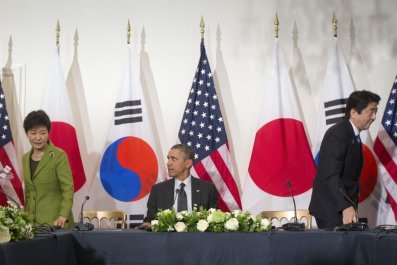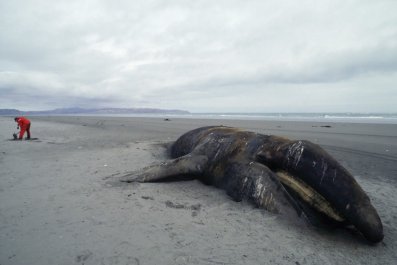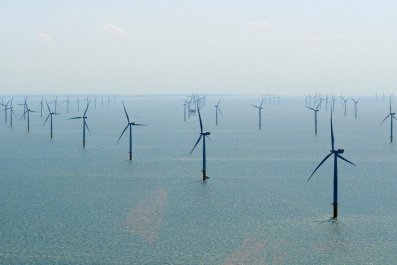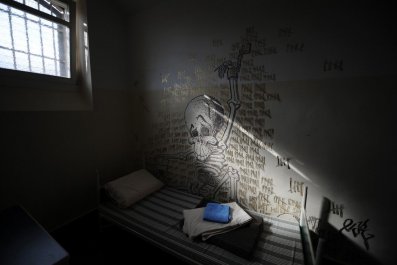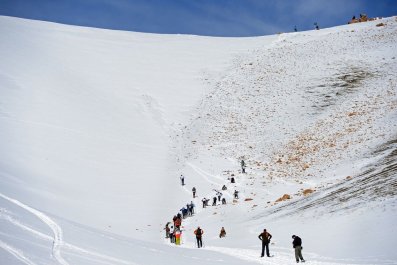Forgive me, please, for being frivolous. I am acutely aware that the situation calls for sobriety. Guantánamo Bay evokes morbid images the world over, but the place is, let's be honest, fundamentally ridiculous, so bizarre that you have to laugh at its existence. It may be tantamount to laughter at a funeral, but it's laughter all the same.
Guantánamo Bay is part Margaritaville and part M*A*S*H, with an ominous touch of Survivor. Guantánamo Bay is where you can order a slice from Pizza Hut inside an Irish pub in which most everyone is drinking Bud Light. Guantánamo Bay has what may be the last Blockbuster outlet on Earth. Guantánamo Bay is a colonial outpost, military base, detention center, beach resort and sleepy fishing village crammed into 45 square miles of rocky Caribbean coast. It is neither Cuba nor America, though it is definitely both.
Guantánamo Bay is a warped American dream, a caliginous sliver of our imperial legacy soothed by the gentle lapping of the Caribbean Sea. A refrain you often hear from the Americans on base is that it is incredibly safe at Guantánamo Bay, especially for children, who can roam here as they presumably no longer can in the United States, which is awash in the depredations of sexual predators and drug fiends and Justin Bieber's posse. Life's irenic rhythms are apparently not threatened by the 154 men imprisoned at the detention camp just over the hill from the W.T. Sampson Elementary School, a few of whom stand legitimately accused of trying to kill Americans through various acts of terror. So, yes, a little dark laughter is in order.
Gitmo is supposedly "the Pearl of the Antilles," a nickname for this remote tip of Cuba, where dry scrubland tumbles toward the sea and lazy iguanas bake in the noonday heat. Havana, 500 miles away, is a distant dream. Much closer is the impoverished nation of Haiti. It, too, is called "the Pearl of the Antilles." History can be cruel like that.
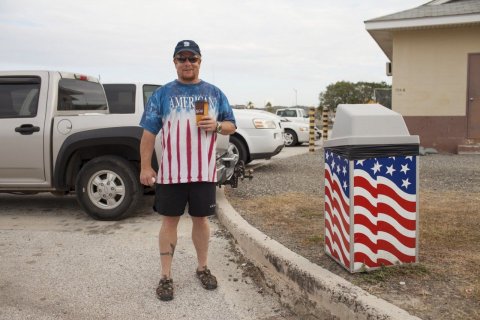
The beaches are best at sunset, when the coral rocks are aflame with an auburn glow. As waves slap against the shore, you can forget about Abd al-Rahim al-Nashiri, who allegedly helped perpetrate the bombing of the USS Cole in 2000, which killed 17 American sailors. He now waits for trial at Camp 7, a secretive prison for about a dozen of Gitmo's supposed worst. Nor do you have to think about, unless you truly want to, Hamdan v. Rumsfeld, the status of supposedly stateless "enemy combatants," the Geneva Conventions or habeas corpus. Nor about the thousands of Haitian refugees who came here in the 1990s in a fruitless search for asylum, nor about how Fidel Castro called the naval base here "a dagger plunged into the heart of Cuban soil," nor about how American forces established a foothold here in 1898, defeating Spain and helping Cuba achieve independence, for which favor the United States was given "complete jurisdiction and control" over this crescent of land in 1903.
You do not have to think about the rent of $4,085 per annum the United States pays, which the Castro brothers (first Fidel and now Raúl) have refused since 1960, nor about the three detainees supposedly found hanging in their cells on June 10, 2006, which officials said was suicide but some think was something else. But as the climbing sun blanches the petrified coral cliffs, you just might be reminded of the white promontories of Dover, England, the ones where the poet Matthew Arnold famously saw "ignorant armies clash by night."
The philosopher Thomas Paine noted in The Age of Reason that the "sublime and the ridiculous are often so nearly related that it is difficult to class them separately." The cliffs on the windward side of the bay, dropping sharply to that perfectly cerulean sea, are sublime. The justifications used to detain most of the suspected terrorists in camps that stand at the edges of those cliffs are, as nearly everyone with any knowledge of constitutional law agrees, ridiculous.

The underwater vistas are sublime in their clarity. The ones aboveground are ridiculously plain, dry hills punctuated by low buildings of mustard and maroon, constructed with such obvious haste and lack of imagination that they make your average suburban strip mall look like the Taj Mahal. Two enormous "golf balls" stand atop a high hill, visible from nearly everywhere on base, as impossible to escape as the Eiffel Tower is in Paris. But you are forbidden from taking pictures of the golf balls because they are radomes supposedly used to collect intelligence. I therefore did not take pictures of the radomes, because though the fear is unreasonable, it feels as though even a minor infraction at Gitmo is going to land you in an orange jumpsuit, behind the barbed wire of Camp Delta.
What are you here for?
Well, about 13 years ago, I was hanging out in Afghanistan and...you?
Funny story. You know those golf balls?
Everyone refers to Guantánamo Bay as "the island," as if it were somehow detached from the greater landmass of Cuba. The detention camps are "inside the wire" or "the JTF side," a reference to the Joint Task Force Guantánamo created in 2002 to manage the suspected terrorists brought here. There are 4,000 Americans on the base. By the end of a week here, it may seem as if you have met every single one of them.
Everyone on base strategically confuses old enemies with new ones. The tagline of Radio GTMO is "Rockin' in Fidel's Backyard," while O'Kelly's advertises itself as "the only Irish pub on Communist soil," which may be true. The prevalent bearded foe is Fidel, not Osama. As a member of the presumably respectable press, I was also called "the enemy" a couple of times, which was strange and ironic and sort of sad. Any journalist found on base is generally assumed to be searching out evidence of waterboarding.
"What the hell was Vanity Fair doing here?" an officer asked me at the Tiki Bar, where I was told those who work with the detainees come to drink.
The answer, sir, is that I have no idea.
Most of the 2,000 laborers here are Jamaican and Filipino. Which of those groups is responsible for "Mongolian Night" at the Bayview Club, I am not sure. Maybe there is a Mongolian contingent here as well; Gitmo, after all, is not a place that easily yields its secrets. In the evenings the foreign workers crowd in front of the library, where there is wireless service, trying to Skype with families back home. This is generally a desperate enterprise, as Internet service on base recalls all the frustrations of the dial-up era, only without the screeching sound of a connection finally made.
You can eat Jamaican food at the Jerk House, but nobody does. You can eat Cuban food at the Cuban Club, but nobody does that either. That is, except for the 22 Cubans who live on base. They decided to cast their lot with Uncle Sam when Fidel Castro came to power in 1959 and now live in a community that looks like a miniature Miami subdivision. The oldest of them, Ramon Baudin, is 91. He used to work at the laundromat and teach karate. Now he spends all day outside, listening to his Panasonic radio, which appears to be as nearly ancient as he is.
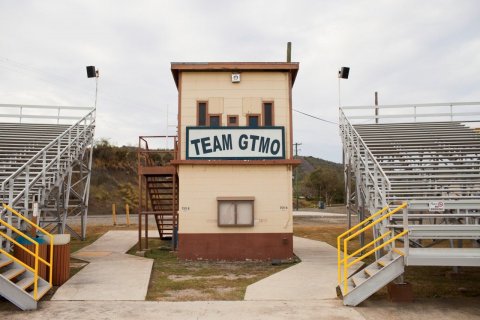
Some Cubans are buried in the base's cemetery. Some of the gravestones there are marked as "Cuban Exile," as if this were an ontological designation. There are many American infants buried there. I don't quite know why.
Signs abound on base warning against becoming "That Guy." These are a public service notice urging moderate alcohol consumption, though when I showed a colleague back in New York City some That Guy swag, he thought it was an injunction against talking loosely about the detainees. Abundant signage also urges you not to feed the iguanas or banana rats.
The main galley at Gitmo is called the Iggy Café, after the prevalent lizards. Dinner there costs about $4. It isn't bad, though the place closes at 6:30. Sometimes, detainees go on hunger strike and have to be force-fed. The cell blocks have arrows that point to Mecca. Everyone is quite proud of this fact. Religion hangs in the air of Gitmo like midafternoon humidity, so pervasive you need not speak about it.
Franklin Delano Roosevelt visited Guantánamo Bay, as did Harry Truman. George W. Bush did not, though his administration is wholly responsible for the erection of the detention center and the byzantine judicial reasoning deployed to sustain it. Nor has President Barack Obama, who promised to close the detention camps opened by his predecessor. He wanted to transfer the detainees to a prison in Illinois. Congress objected. Maybe the next president will figure out what to do with the men detained at Guantánamo. Or maybe the one after.
Not that Gitmo lacks visitors of the voluntary variety. When I was in Guantánamo in January, posters advertised the imminent arrival of "The Most Interesting Man in the World" from those funny Dos Equis commercials. His real name is Jonathan Goldsmith. He was invited by the office of Morale, Welfare and Recreation, which is responsible for keeping the servicemembers entertained, or at least not begging for a subsequent deployment in bustling Guam or cosmopolitan Alaska.
Stephen Crane, author of The Red Badge of Courage, came here in 1898 as a war correspondent with the Marine Corps, which was helping rid Cuba of its Spanish colonial masters. In "Marines Signaling Under Fire at Guantánamo," he writes of how "one felt like a leaf in this booming chaos, this prolonged tragedy of the night."
Mike Wallace of 60 Minutes arrived in Gitmo for a faux vacation in 1972, extolling the "strangely tranquil" base's recreation while explaining, with just the right touch of glee, that its beaches were inaccessible to the average American. These days, on Friday nights, one of these beaches is used by the Filipino population for what I understand is a quite lively karaoke party.
There are so many playgrounds that I lost count after 10. There are so few firearms that I didn't see a semiautomatic weapon until my penultimate day on base: a .50-caliber machine gun mounted on a Coast Guard boat, a lonesome black stork pointing its deadly beak into the water.
Everyone on base scuba dives. Everyone on base knows to stand erectly when "The Star-Spangled Banner" plays through a loudspeaker at 8 every morning. Everyone knows to remove his hat indoors.
One night, I went to one of the base's outdoor movie theaters to watch Lone Survivor, about a disastrous 2005 mission in the mountains of Afghanistan that left 19 Americans dead. The only thing that could have been more surreal than watching that sanguinary tragedy with the soldiers of Guantánamo Bay would have been to watch it with the detainees of Guantánamo Bay.
Some say the Cubans on the other side of the 17-mile fence that encloses Gitmo eat iguanas. Banana rats, others claim. I bought my daughter a stuffed banana rat at the Navy Exchange, a lusterless imitation of Wal-Mart. The toy has a "Guantánamo Bay, Cuba" medallion on its side and a disgustingly accurate tail. I could have also gotten my daughter toddler-sized Navy fatigues, but that seemed like a waste for someone who is not yet old enough to fully appreciate irony.
A woman tried to buy me lemon drops at O'Kelly's. I stuck to Dogfish. Then the Dogfish ran out, because all goods arrive at Gitmo on a barge that comes only twice each month. So I switched to Bass. The bar is straight out of Cheers, except with worse haircuts and flatter accents. It is next to the Windjammer Café, down the block from the bowling alley, the golf course and the skate park, not to mention the schools, the marina, a thrift store, a McDonald's, a Taco Bell and, in the airfield waiting room, a Subway. That same waiting room has a fine collection of warplane models. So there's that.
The flight between Guantánamo Bay and the Jacksonville Naval Air Station, on a chartered jet, costs nearly as much for a civilian as a round-trip ticket between London and New York. Though some Americans who have their families on base do relish their Pleasantville-on-the-Caribbean fantasy, most people at Guantánamo Bay would love to be on that flight back to the States. That goes for the detainees and the men and women who guard them, for they are captives all.
They used to call Guantánamo "Git Mo'," a reference to the brothels of the nearby town of Caimanera, where one pleasure-seeker found Cuban prostitutes "accommodating 'our boys' in ways Mother never intended." The current inaccessibility of said carnal enjoyments is just one of the many results of the long-standing, and by now totally pointless, hostilities between Cuba and the United States. However, the Marines who guard the fence line say that, from their watchtowers, they can see Cuban soldiers line up to enter these legendary prostitution dens.
Like pretty much everything else at Guantánamo Bay, this sounds too ridiculous to not be true.




